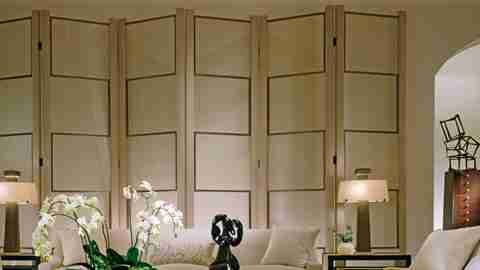Betting the House
View Slideshow

On his very first trip to Las Vegas, in 2003, interior designer Thomas Pheasant did what any visitor to the city would do: He took a chance. The gamble, in this instance, was on a pair of clients who had called him up in Washington, D.C., and asked him to come out and take a look at their 12,000-square-foot Mediterranean-style house, nestled in a quiet residential community about 25 minutes away from the Las Vegas Strip. Pheasant, whose serene, carefully balanced interiors are a natural fit for a stately city like Washington, found the whole thing curious. "My first thought was, wow, why would somebody from Las Vegas want to hire me?" he says. "But, clearly, they were calling me because they had seen my work. I guess they had liked what they'd seen."
Indeed, the clients, Rob and Sheryl Goldstein, were passionate, if secret, admirers of Pheasant's. "Sheryl always referenced design magazines looking for the right person to do this house," says her husband. "She continually removed pages of Tom's work until I asked her why she didn't just call him. She was a bit intimidated. I finally called his office and spoke with Tom. He came to see us. His ideas were so well articulated; he approached the house from both an architectural and a design perspective."
Pheasant's holistic approach—he's definitely not the type of designer who's content simply to shop for furniture and pick paint colors—could easily have overwhelmed the Goldsteins. As he made his initial walk-through, he couldn't help but make a silent structural critique. "I felt like there were things about the house that required attention. I don't talk a lot when I first meet people, but I was thinking the whole time: Well, they're a charming couple, but I'm not sure my work will translate well within the existing space. I drove away thinking that I'd love to work with them and that I'd love the challenge of the project —but I didn't want merely to decorate."
And so Pheasant, in the parlance of blackjack, doubled down—and won the hand. The Goldsteins hired him to do a complete renovation, and the three of them began working to turn the house from something perfectly lovely but unspectacular into something unique. As Pheasant worked, he was surprised—happily—to learn that his clients were becoming bolder with each new bit of demolition. "The scope of the project grew so much in that first year," he says. "When they met me, I don't think they realized how far we were going to go. Had I told them in that first meeting, I think they might have said, Well, we like you, but you're not quite the right person for the job.' But later on they actually got excited—they would come to me after we had just destroyed a wall and say, Hey, when you're done with that, how about doing this?'"
One of the things that had immediately bothered Pheasant when he visited the Goldsteins' house had been the front door. "It was just a single, wooden door," he says. "When you closed it behind you, the entrance hall seemed so small and dark that it almost felt like a rear entry." The redesigned façade now features a grand arch and glass double doors that flood the entrance hall with light and, in Pheasant's words, "prepare you for the massive space you're about to encounter."
He's referring to the stairwell rotunda, a soaring volume that seems to rise up to heaven in a breathtaking swirl. Pheasant brought it down to earth, just a little. "The previous owners had used it as a dining room," he says. "But I thought: It's like eating at the bottom of a mine shaft. We broke up the height, visually, with upholstered walls. And the light fixture"—a long, slender cylinder of ivory silk ringed with hammered bronze, custom-designed by Pheasant—"brings the ceiling down, though you still get the sense of space. But at least you don't feel like you're at the bottom of a well."
In other rooms, Pheasant gave his clients the same combination of muted tones, quietly elegant fabrics and harmonious arrangements that Sheryl Goldstein had seen and loved in the photographs she had clipped. Custom furnishings, such as the living room's mahogany cabinet with woven-bronze front, reflect Pheasant's uncanny ability to evoke precedents while still managing to look way ahead of the curve.
Summing up the project, Sheryl Goldstein offers what might as well be Pheasant's mission statement. "Our home was meant to be understated and sophisticated, with a classic sensibility, the type of environment that you could see anywhere—Los Angeles, Chicago or New York."
Of course, the house isn't just anywhere: It's in Las Vegas, the capital of a certain type of sophistication, to be sure, though not necessarily the capital of understatement. Be that as it may, Thomas Pheasant, heeding the title of Robert Venturi's seminal study of the city's culture and architecture, has learned from Las Vegas.
"Over the last four years I've come to really appreciate what Las Vegas is all about," he says. "I love it as a form of aesthetic theater, from retail to restaurants to residences." So the quiet intellectual from Washington, D.C., turns out to be a big fan of the city of glamour and glitz. What were the odds?